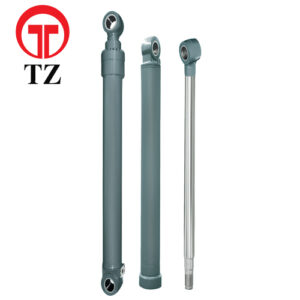Performing regular maintenance tasks on the boom cylinder of an excavator helps ensure its optimal performance and extend its lifespan.
Here are some common maintenance tasks for the boom cylinder:
Visual Inspection: Regularly inspect the boom cylinder for any signs of damage, leaks, or wear. Look for hydraulic fluid leaks around the seals, cracks or dents on the cylinder barrel, and any loose or damaged mounting hardware.
Seal Inspection and Replacement: Check the hydraulic seals on the boom cylinder for signs of leakage or wear. Leaking seals can lead to decreased performance and potential damage to other hydraulic components. Replace any worn or damaged seals promptly.
Lubrication: Follow the manufacturer’s recommendations for lubrication of the boom cylinder. Apply the appropriate lubricant to the cylinder’s moving parts, such as the piston rod, to ensure smooth operation and reduce friction.
Cleaning: Regularly clean the boom cylinder to remove dirt, debris, and other contaminants. Use a soft cloth or brush and mild detergent if necessary. Keeping the cylinder clean helps prevent the accumulation of abrasive particles that can damage seals or cause internal wear.
Hydraulic Fluid Inspection: Check the hydraulic fluid level and quality regularly. Ensure that the fluid level is within the recommended range and that it is clean and free from contamination. If necessary, drain and replace the hydraulic fluid as per the manufacturer’s guidelines.
Pressure Testing: Periodically test the hydraulic pressure of the boom cylinder using appropriate pressure gauges. This ensures that the cylinder is operating within the specified pressure range and helps identify any potential issues with the hydraulic system.
Mounting Hardware Inspection: Inspect the mounting pins, brackets, and other hardware that secure the boom cylinder. Ensure they are properly tightened and free from damage or signs of wear. Replace any worn or damaged hardware to maintain a secure connection.
Regular Maintenance Schedule: Create a regular maintenance schedule for the boom cylinder based on the manufacturer’s recommendations. Follow the schedule to ensure timely inspections, lubrication, and other maintenance tasks.
It’s important to consult the specific maintenance guidelines provided by the excavator manufacturer for detailed instructions and recommendations regarding the boom cylinder. Adhering to these maintenance tasks can help optimize the performance, reliability, and safety of the boom cylinder and the overall excavator operations.
What are some signs that indicate the boom cylinder seals need to be replaced?
There are several signs that indicate the boom cylinder seals may need to be replaced. Here are some common indicators to look out for:
Hydraulic Fluid Leaks: One of the most obvious signs of seal failure is the presence of hydraulic fluid leaks around the boom cylinder. If you notice fluid accumulating or dripping from the cylinder, it indicates that the seals are not effectively containing the hydraulic pressure. Leaks may appear as visible drips or as wet spots around the cylinder.
Reduced Performance: If you notice a decrease in the boom cylinder’s performance, such as slow or jerky movement, difficulty extending or retracting the cylinder, or lack of smooth operation, China excavator boom cylinder it could be a sign of worn or damaged seals. Seals that no longer provide a tight seal can result in decreased hydraulic pressure and compromised cylinder movement.
Increased Hydraulic Fluid Consumption: If you find that the excavator’s hydraulic fluid levels consistently decrease and require frequent refills, it may be due to seal failure. Leaking seals can cause hydraulic fluid to escape the system, leading to a noticeable increase in fluid consumption.
External Seal Damage: Visually inspect the boom cylinder seals for any visible signs of damage, such as cracks, tears, or excessive wear. Damaged seals are more prone to leakage and can compromise the overall performance of the boom cylinder.
Abnormal Noises: Unusual noises, such as hissing or whistling sounds, during the operation of the boom cylinder may indicate seal problems. These noises can occur when hydraulic fluid is escaping through worn seals, causing air to enter the system.
Cylinder Drift: If the boom cylinder exhibits uncontrolled movement or drifts when it should remain stationary, it could be a sign of seal failure. Worn or damaged seals may not effectively hold the hydraulic pressure, resulting in unintended cylinder movement.
If you observe any of these signs, it is recommended to have a qualified technician inspect the boom cylinder and seals. They can assess the condition of the seals and determine whether replacement is necessary. Timely seal replacement helps maintain the proper functioning of the boom cylinder, prevents further damage, and ensures the safety and efficiency of the excavator.
